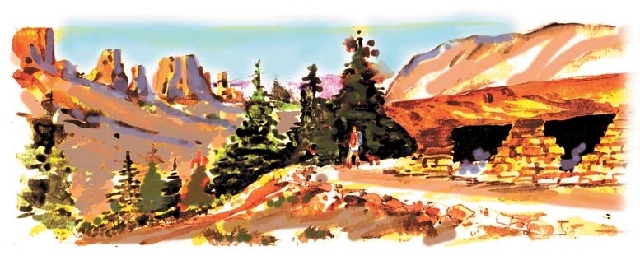Arizona’s Walnut Canyon home to ancient cliff dwellings
Walnut Canyon is an eroded gash in the forested plateau surrounding Flagstaff, Ariz. The canyon contains 20 miles of diverse habitat along a creek named for the native Arizona walnut trees that grow there. Early pioneers discovered that they were not the first settlers in the area when they found ancient cliff dwellings tucked into ledges beneath the rim of the canyon.
The ruins soon attracted unwanted attention from “pot hunters.” To protect the place from further plundering and damage, Walnut Canyon was set aside as a federal preserve in 1915. Initially under U.S. Forest Service management, a six-mile portion of Walnut Canyon became a national monument in 1934 under National Park Service administration. The monument’s early facilities were constructed by the Civilian Conservation Corps in the 1930s and ’40s. The monument today includes 3,600 square miles of cliffs, streamside canyon bottom and forested rim.
Flagstaff is about 250 miles from Las Vegas by way of U.S. Highway 93 to Kingman, Ariz., and Interstate 40 from Kingman to Flagstaff. The cliff dwellings in Walnut Canyon National Monument are about 10 miles from the center of Flagstaff. Follow I-40 east to exit 204. Drive south three miles to parking near the visitor center. Exhibits inside introduce the native people who once occupied Walnut Canyon. Facilities include the visitor center overlooking the gorge, restrooms, a picnic area and two trails. There are no camping facilities. Pets are not allowed beyond the parking lot.
Open daily year-round, except for Christmas Day, Walnut Canyon National Monument annually welcomes about 100,000 visitors. From May through October, the monument is open from 8 a.m. to 5 p.m. Mountain time. From November through April, the park opens an hour later. Entry costs $5 for visitors 16 and older.
A fairly level route, the Rim Trail explores the edge of the plateau, linking several vantage points with outstanding views into the canyon. It is wheelchair accessible as far as the first overview. The Island Trail is not long but drops 185 feet from the visitor center into the canyon for close-up views of cliff dwellings. This trail is not accessible for wheelchairs or strollers as it descends and returns by way of 240 steep stairs. Don’t attempt this route if you are not in shape for the climb. Part of the trail is currently closed for maintenance work. Allow at least two hours to peruse the exhibits and follow the Rim Trail and additional time for the Island Trail.
The ruins reveal details of a culture that lived in the area from 600 to 1400. These people are called the Sinagua, Spanish for “without water.”
Their way of life was based on farming, hunting and harvesting native plants. They obtained drinking water from the creek and a few seeps but practiced dry farming. Family groups raised beans, corn and squash near the rim.
They began to wall up limestone alcoves in the canyon’s steep cliffs about 1100. Abandoned about 600 years ago, the cramped rooms provided protection and shelter for more than 100 people.
Walnut Creek’s dependable flow of water in an arid area appealed to native people searching for hospitable living conditions. Walnut Canyon attracted many kinds of animals. Its varied habitats made for good hunting and supported many types of plants.
Even today, with its flow diminished by upstream reservoirs, Walnut Creek supports a diverse ecosystem. It is home to 69 mammals, 28 kinds of reptiles and amphibians an at least 121 species of birds.
From Memorial Day to Labor Day, visitors can take advantage of several programs with Forest Service and Park Service rangers. Popular ones include the strenuous, three-hour Ledge Hike with a ranger at 9 a.m. on the second and fourth Saturdays of the month and the easy, two-hour guided walk to an old ranger cabin at 9:15 a.m. on Sundays. Call 928-526-3367 for program schedules and reservations.
Margo Bartlett Pesek’s column appears on Sundays.






















